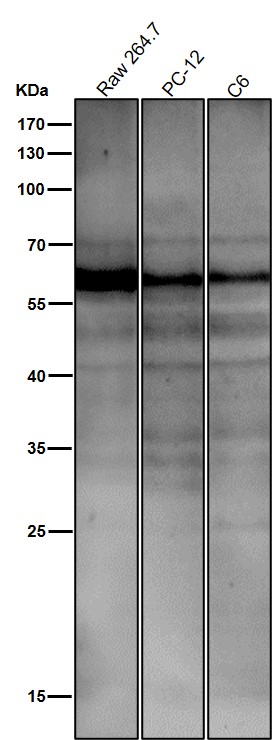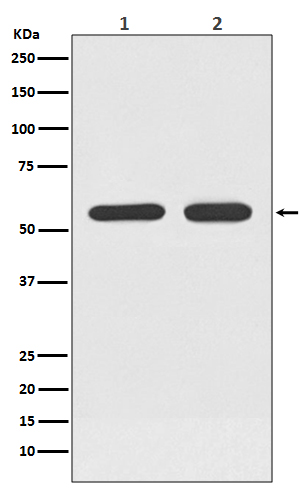Anti-ATF7 Rabbit Monoclonal Antibody
- SPECIFICATION
- CITATIONS
- PROTOCOLS
- BACKGROUND

Application
| WB |
|---|---|
| Primary Accession | P17544 |
| Host | Rabbit |
| Isotype | Rabbit IgG |
| Reactivity | Rat, Human, Mouse |
| Clonality | Monoclonal |
| Format | Liquid |
| Description | Anti-ATF7 Rabbit Monoclonal Antibody . Tested in WB application. This antibody reacts with Human, Mouse, Rat. |
| Gene ID | 11016 |
|---|---|
| Other Names | Cyclic AMP-dependent transcription factor ATF-7, cAMP-dependent transcription factor ATF-7, Activating transcription factor 7, Transcription factor ATF-A, ATF7, ATFA |
| Calculated MW | 52967 MW KDa |
| Application Details | WB 1:500-1:1000 |
| Subcellular Localization | Nucleus. Nucleus, nucleoplasm. Mainly nucleoplasmic. Restricted distribution to the perinuculear region. The sumoylated form locates to the nuclear periphery. |
| Tissue Specificity | Expressed in heart, lung and skeletal muscle. Isoform 4 is expressed in various tissues including heart, brain, placenta, lung and skeletal muscle. Highest levels in skeletal muscle. Lowest in lung and placenta.. |
| Contents | Rabbit IgG in phosphate buffered saline, pH 7.4, 150mM NaCl, 0.02% sodium azide and 50% glycerol, 0.4-0.5mg/ml BSA. |
| Clone Names | Clone: HBD-1 |
| Immunogen | A synthesized peptide derived from human ATF7 |
| Purification | Affinity-chromatography |
| Storage | Store at -20°C for one year. For short term storage and frequent use, store at 4°C for up to one month. Avoid repeated freeze-thaw cycles. |
| Name | ATF7 |
|---|---|
| Synonyms | ATFA |
| Function | Stress-responsive chromatin regulator that plays a role in various biological processes including innate immunological memory, adipocyte differentiation or telomerase regulation (PubMed:29490055). In absence of stress, contributes to the formation of heterochromatin and heterochromatin-like structure by recruiting histone H3K9 tri- and di-methyltransferases thus silencing the transcription of target genes such as STAT1 in adipocytes, or genes involved in innate immunity in macrophages and adipocytes (By similarity). Stress induces ATF7 phosphorylation that disrupts interactions with histone methyltransferase and enhances the association with coactivators containing histone acetyltransferase and/or histone demethylase, leading to disruption of the heterochromatin-like structure and subsequently transcriptional activation (By similarity). In response to TNF-alpha, which is induced by various stresses, phosphorylated ATF7 and telomerase are released from telomeres leading to telomere shortening (PubMed:29490055). Also plays a role in maintaining epithelial regenerative capacity and protecting against cell death during intestinal epithelial damage and repair (By similarity). |
| Cellular Location | Nucleus {ECO:0000255|PROSITE-ProRule:PRU00978, ECO:0000269|PubMed:17264123}. Nucleus, nucleoplasm. Chromosome, telomere. Note=Mainly nucleoplasmic. Restricted distribution to the perinuculear region. The sumoylated form locates to the nuclear periphery |
| Tissue Location | Expressed in various tissues including heart, brain, placenta, lung and skeletal muscle. Highest levels in skeletal muscle. Lowest in lung and placenta. |

Thousands of laboratories across the world have published research that depended on the performance of antibodies from Abcepta to advance their research. Check out links to articles that cite our products in major peer-reviewed journals, organized by research category.
info@abcepta.com, and receive a free "I Love Antibodies" mug.
Provided below are standard protocols that you may find useful for product applications.
If you have used an Abcepta product and would like to share how it has performed, please click on the "Submit Review" button and provide the requested information. Our staff will examine and post your review and contact you if needed.
If you have any additional inquiries please email technical services at tech@abcepta.com.













 Foundational characteristics of cancer include proliferation, angiogenesis, migration, evasion of apoptosis, and cellular immortality. Find key markers for these cellular processes and antibodies to detect them.
Foundational characteristics of cancer include proliferation, angiogenesis, migration, evasion of apoptosis, and cellular immortality. Find key markers for these cellular processes and antibodies to detect them. The SUMOplot™ Analysis Program predicts and scores sumoylation sites in your protein. SUMOylation is a post-translational modification involved in various cellular processes, such as nuclear-cytosolic transport, transcriptional regulation, apoptosis, protein stability, response to stress, and progression through the cell cycle.
The SUMOplot™ Analysis Program predicts and scores sumoylation sites in your protein. SUMOylation is a post-translational modification involved in various cellular processes, such as nuclear-cytosolic transport, transcriptional regulation, apoptosis, protein stability, response to stress, and progression through the cell cycle. The Autophagy Receptor Motif Plotter predicts and scores autophagy receptor binding sites in your protein. Identifying proteins connected to this pathway is critical to understanding the role of autophagy in physiological as well as pathological processes such as development, differentiation, neurodegenerative diseases, stress, infection, and cancer.
The Autophagy Receptor Motif Plotter predicts and scores autophagy receptor binding sites in your protein. Identifying proteins connected to this pathway is critical to understanding the role of autophagy in physiological as well as pathological processes such as development, differentiation, neurodegenerative diseases, stress, infection, and cancer.




